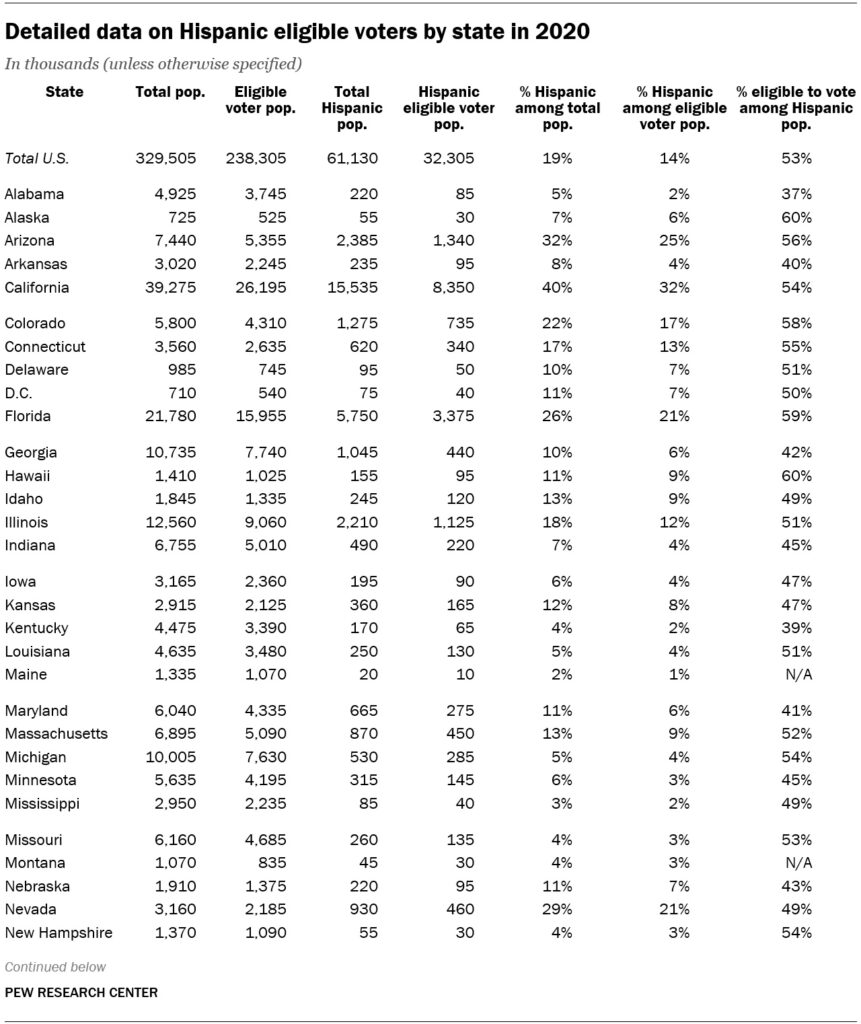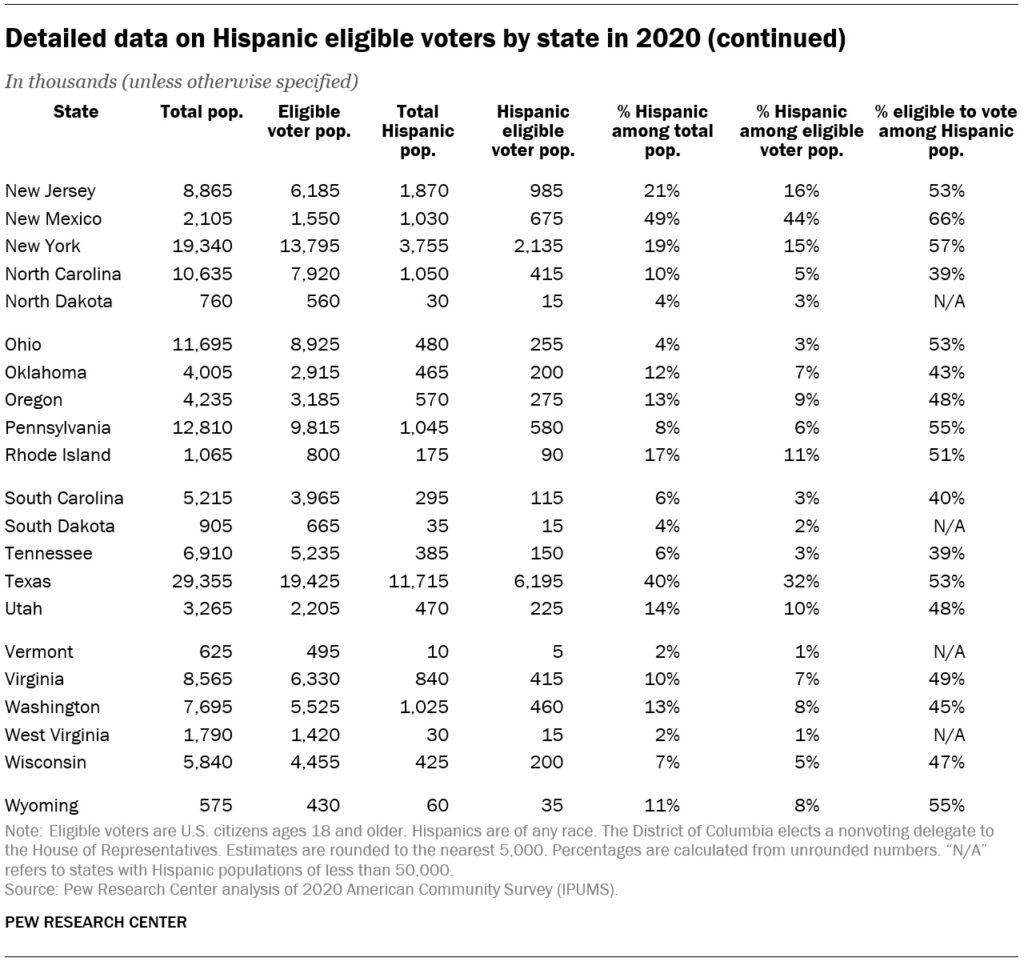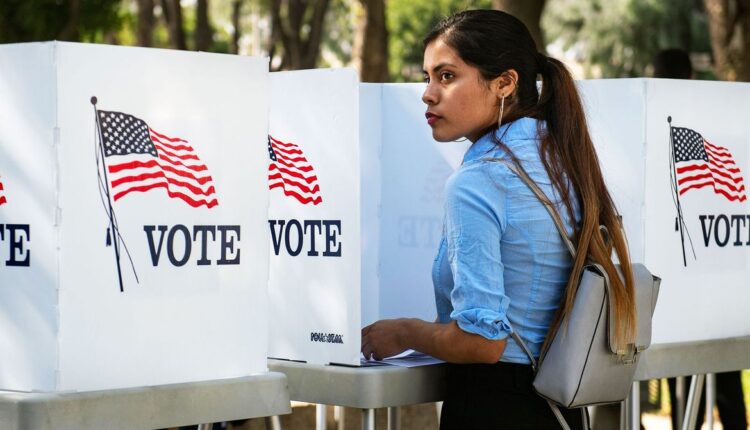
Key facts about Hispanic eligible voters in 2022
By Anusha Natarajan and Carolyne Em / Pew Research Center
An estimated 34.5 million Hispanic Americans are eligible to vote this year, making Latinos the fastest-growing racial and ethnic group in the U.S. electorate since the last midterm elections. The number of Hispanic eligible voters has increased by 4.7 million since 2018, representing 62% of the total growth in U.S. eligible voters during this time.
Although then-President Donald Trump made gains among Hispanics in 2020, Latino registered voters are still more likely to say they will support the Democratic candidate rather than Repu
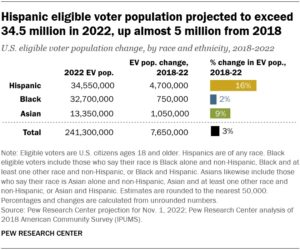
blican candidate in their U.S. House district race, according to an August 2022 Pew Research Center survey. In midterm elections, turnout rates among Hispanic Americans have typically trailed those of some other groups.
As the midterm elections approach, here are five key facts about Hispanic eligible voters in the United States, based on Pew Research Center projections for 2022, as well as Census Bureau data for previous years. (Eligible voters in this analysis are defined as citizens ages 18 and older residing in the 50 states and the District of Columbia. Not all eligible voters are actually registered to vote.
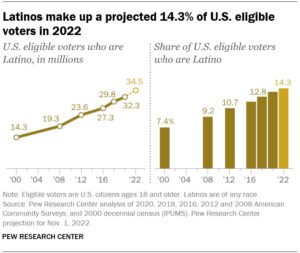 1.Latinos are projected to account for 14.3% of all eligible voters in November 2022, a new high. This share has steadily increased over the past two decades and is up from 12.8% in 2018. In 2000, by comparison, Hispanics made up just 7.4% of U.S. eligible voters.
1.Latinos are projected to account for 14.3% of all eligible voters in November 2022, a new high. This share has steadily increased over the past two decades and is up from 12.8% in 2018. In 2000, by comparison, Hispanics made up just 7.4% of U.S. eligible voters.
The number of Hispanic eligible voters has increased from 29.8 million in 2018 to 34.5 million today. This projection is up from 14.3 million in 2000, a 142% increase.
From 2000 to 2018, Latinos were the biggest drivers of growth in the nation’s eligible voter population growth, with increases in all 50 states and D.C.
2.California is home to about a quarter of all Hispanic eligible voters. Some 8.3 million out of the nation’s 32.3 million Hispanic eligible voters, or 26%, resided in the state of California in 2020. Texas has the second-largest number of Hispanic eligible voters, with 6.2 million, followed by 3.4 million in Florida, 2.1 million in New York and 1.3 million in Arizona. Together, these five states hold about two-thirds (66%) of all Hispanic eligible voters.
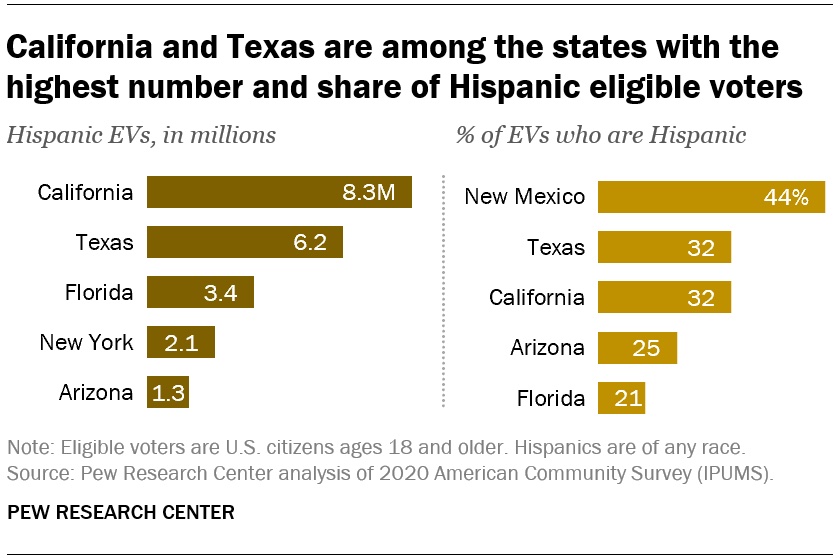 3.In New Mexico, 44% of all eligible voters are Latino, the highest share of any state. New Mexico is also the only state in which Latinos make up a higher share of the total eligible voter population than any other racial or ethnic group. This includes Americans who are White alone and non-Hispanic, who account for 42% of New Mexico’s eligible voters.
3.In New Mexico, 44% of all eligible voters are Latino, the highest share of any state. New Mexico is also the only state in which Latinos make up a higher share of the total eligible voter population than any other racial or ethnic group. This includes Americans who are White alone and non-Hispanic, who account for 42% of New Mexico’s eligible voters.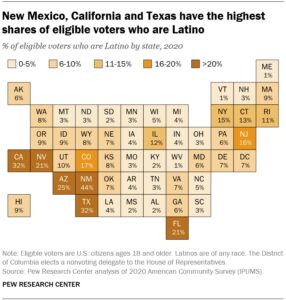
In California and Texas, Hispanics are nearly a third of the eligible voter population (32% in each state). California and Texas are also the only states where non-Hispanics who are White and no other race make up a plurality, but not a majority, of the eligible voter population (43% in California and 48% in Texas). In both states, Hispanics hold the second-highest share among major racial and ethnic groups.
Arizona (25%), Florida (21%) and Nevada (21%) are the states with the next-largest Latino shares of all eligible voters. And in three other states – Colorado (17%), New Jersey (16%) and New York (15%) – Latinos account for about one-in-six eligible voters in each state.
4. A narrow majority of Latinos in the U.S. are eligible to vote. A little over half of all Latinos (53%) were eligible to vote in 2020, an increase from 50% in 2018. But the share varies widely by state.
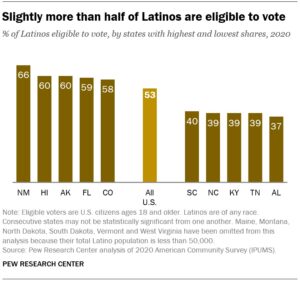 In New Mexico, 66% of all Latinos are eligible to vote, the highest share in states with a Latino population of 50,000 or more. In North Carolina, Kentucky and Tennessee, by comparison, 39% of all Latinos are eligible to vote, followed by Alabama at 37%.
In New Mexico, 66% of all Latinos are eligible to vote, the highest share in states with a Latino population of 50,000 or more. In North Carolina, Kentucky and Tennessee, by comparison, 39% of all Latinos are eligible to vote, followed by Alabama at 37%.
Latinos are considerably less likely than Americans overall to be eligible to vote (53% vs. 72%). This is partly because the nation’s Latino population includes a large number of people who are too young to vote or who are not U.S. citizens. A higher share of Latinos are under the age of 18 compared with the total U.S. population (30% vs. 22%). And 18% of the nation’s Latinos are not U.S. citizens, compared with 6% of the total U.S. population. Latino immigrants who are not eligible to vote include permanent residents (green card holders) and those in the process of becoming permanent residents; those in the U.S. on temporary visas; and unauthorized immigrants.
5.Hispanic eligible voters tend to be younger than eligible voters overall, and they differ from the broader electorate in other ways, too. The median age of Latino eligible voters is 39, nine years younger than the median age of all U.S. adult eligible voters (48). Only about three-in-ten Latino eligible voters (32%) are age 50 or older, compared with nearly half of all U.S. eligible voters (47%).
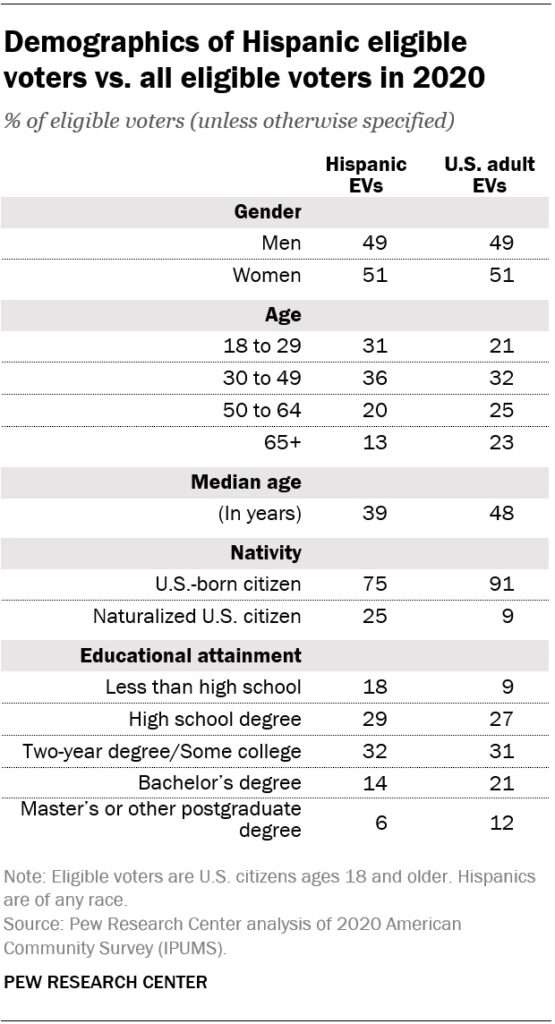 When it comes to education, nearly a third of Hispanic eligible voters (32%) have a two-year degree or just some college experience. By comparison, a similar share of all U.S. adult eligible voters (31%) have a two-year degree or just some college experience. Eligible voters overall are more likely than Hispanic eligible voters to have a bachelor’s degree or higher (33% vs. 20%).
When it comes to education, nearly a third of Hispanic eligible voters (32%) have a two-year degree or just some college experience. By comparison, a similar share of all U.S. adult eligible voters (31%) have a two-year degree or just some college experience. Eligible voters overall are more likely than Hispanic eligible voters to have a bachelor’s degree or higher (33% vs. 20%).
